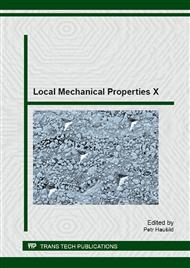[1]
B. Goszczyńska, Analysis of the process of crack initiation and evolution in concrete with acoustic emission testing, Archives of Civil and Mechanical Engineering. 14-1 (2014) 134-143.
DOI: 10.1016/j.acme.2013.06.002
Google Scholar
[2]
M. Sansalone, W. Streett, Impact-echo: Nondestructive Evaluation of Concrete and Masonry, Bullbrier Press, Ithaca, (1997).
Google Scholar
[3]
B. Goszczyńska, G. Świt, W. Trąmpczyński, A. Krampikowska, J. Tworzewska, P. Tworzewski, Experimental validation of concrete crack identification and location with acoustic emission method, Archives of Civil and Mechanical Engineering. 12-1 (2012).
DOI: 10.1016/j.acme.2012.03.004
Google Scholar
[4]
A. Klepka, W. Staszewski, B. Jenal, M. Szwedo, J. Iwaniec, T. Uhl, Nonlinear acoustics for fatigue crack detection–experimental investigations of vibro-acoustic wave modulations, Structural Health Monitoring. 11-2 (2012) 197-211.
DOI: 10.1177/1475921711414236
Google Scholar
[5]
K. Schabowicz, Methodology for non-destructive identification of thickness of unilaterally accessible concrete elements by means of state-of-the-art acoustic techniques, Journal of Civil Engineering and Management. 19-3 (2013): 325-334.
DOI: 10.3846/13923730.2012.757562
Google Scholar
[6]
J. Hoła, L. Sadowski, K. Schabowicz, Non-destructive identification of delaminations in concrete floor toppings with acoustic methods, Automation in Construction. 20-7 (2011) 799-807.
DOI: 10.1016/j.autcon.2011.02.002
Google Scholar
[7]
L. Sadowski, Non-destructive evaluation of the pull-off adhesion of concrete floor layers using RBF neural network. Journal of Civil Engineering and Management. 19-4 (2013) 550-560.
DOI: 10.3846/13923730.2013.790838
Google Scholar
[8]
A. Ali Shaha, Y. Ribakov, Non-destructive measurements of crack assessment and defect detection in concrete structures, Materials & Design. 29-1 (2008) 61–69.
DOI: 10.1016/j.matdes.2006.12.002
Google Scholar
[9]
C. Hsiao, C. Cheng, T. Liou, Y. Juang, Detecting flaws in concrete blocks using the impact-echo method, NDT&E International. 41 (2008) 98–107.
DOI: 10.1016/j.ndteint.2007.08.008
Google Scholar
[10]
Standard test method for measuring the P-wave speed and the thickness of concrete plates using the impact-echo method, American Society for Testing and Materials, (1998).
DOI: 10.1520/c1383-04r10
Google Scholar


